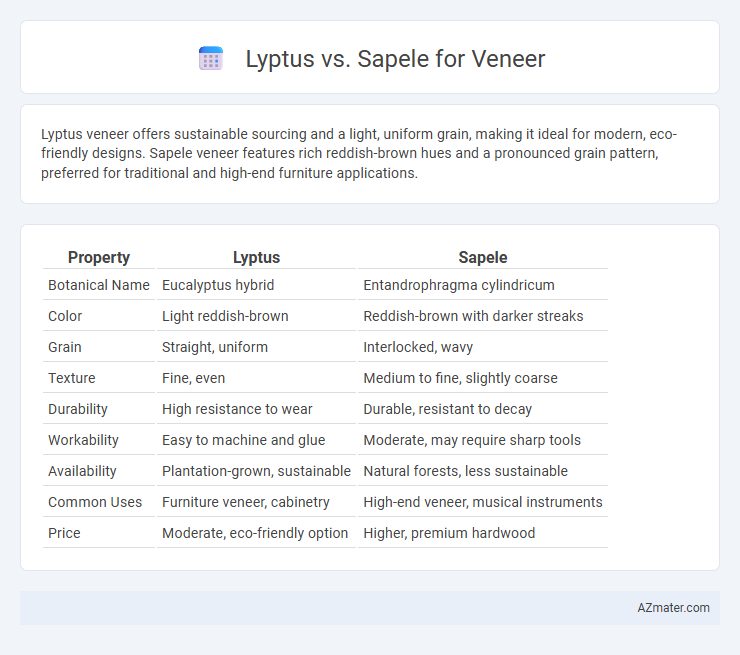Lyptus veneer offers sustainable sourcing and a light, uniform grain, making it ideal for modern, eco-friendly designs. Sapele veneer features rich reddish-brown hues and a pronounced grain pattern, preferred for traditional and high-end furniture applications.
Table of Comparison
| Property | Lyptus | Sapele |
|---|---|---|
| Botanical Name | Eucalyptus hybrid | Entandrophragma cylindricum |
| Color | Light reddish-brown | Reddish-brown with darker streaks |
| Grain | Straight, uniform | Interlocked, wavy |
| Texture | Fine, even | Medium to fine, slightly coarse |
| Durability | High resistance to wear | Durable, resistant to decay |
| Workability | Easy to machine and glue | Moderate, may require sharp tools |
| Availability | Plantation-grown, sustainable | Natural forests, less sustainable |
| Common Uses | Furniture veneer, cabinetry | High-end veneer, musical instruments |
| Price | Moderate, eco-friendly option | Higher, premium hardwood |
Introduction to Lyptus and Sapele Veneer
Lyptus veneer, derived from Eucalyptus grandis x Eucalyptus urophylla hybrid trees, offers a sustainable alternative with a fine, uniform grain and a consistent pale to reddish-brown color ideal for modern furniture and cabinetry. Sapele veneer, sourced from the African Sapele tree (Entandrophragma cylindricum), features a rich reddish-brown hue with interlocking grain patterns that produce a natural chatoyant effect, often preferred for high-end architectural woodwork and musical instruments. Both veneers provide durable, visually appealing surfaces, with Lyptus known for its rapid growth and eco-friendliness, while Sapele is prized for its classic warmth and striking grain complexity.
Botanical Origins and Sustainability
Lyptus veneer originates from Eucalyptus grandis and Eucalyptus urophylla hybrids, known for rapid growth and renewable plantation sourcing, enhancing its sustainability profile. Sapele veneer is derived from Entandrophragma cylindricum, an African hardwood species with slower growth rates, often harvested from natural forests, raising concerns about deforestation. Lyptus offers a more sustainable option due to controlled plantation management, while Sapele's sustainability depends heavily on certification and responsible forestry practices.
Appearance and Grain Patterns
Lyptus veneer features a consistent, fine grain with a smooth texture and a light reddish-brown color that deepens over time, making it ideal for modern, uniform designs. Sapele veneer showcases a more intricate interlocking grain pattern with a rich reddish-brown hue and natural shimmering figure, offering a distinctive, decorative appeal. Both woods provide durability, but Lyptus is favored for its predictable grain and coloration, while Sapele stands out with its dramatic grain variations and visual depth.
Color Variations and Aging
Lyptus veneer showcases a consistent reddish-brown color that darkens evenly with age, maintaining its rich, warm tone over time. Sapele veneer exhibits more pronounced color variations, ranging from golden to deep reddish-brown hues, which develop a beautiful patina that enhances its character as it ages. Both woods offer distinct aging properties, with Lyptus providing uniformity and Sapele delivering dynamic color shifts that appeal to diverse design preferences.
Durability and Hardness Comparison
Lyptus veneer exhibits a Janka hardness of about 1,500, making it significantly harder and more durable than Sapele, which has a Janka rating close to 1,410. The higher density of Lyptus contributes to superior resistance to dents and wear, ideal for high-traffic areas or furniture subjected to frequent use. Sapele, while moderately durable, offers slightly better flexibility but is more prone to surface scratches compared to the robust, wear-resistant Lyptus veneer.
Workability and Machining Properties
Lyptus offers excellent workability and machining properties due to its uniform density and fine, consistent grain, allowing clean cuts and minimal wear on tools. Sapele veneer, while durable with a slightly interlocked grain, can pose more challenges during machining, often requiring sharper blades to prevent tear-out. Both woods respond well to sanding and finishing, but Lyptus provides smoother results for intricate veneer applications.
Finishing and Staining Suitability
Lyptus veneer offers excellent uniformity in grain and density, making it highly receptive to various finishes and producing a smooth, consistent stain absorption ideal for achieving rich, even tones. Sapele veneer, known for its interlocking grain and natural luster, responds well to staining but requires careful application to avoid blotchiness or uneven coloration due to its variable grain pattern. Both veneers are compatible with oil-based and water-based finishes, but Lyptus provides a more predictable staining outcome for projects demanding precise color control.
Cost and Availability Factors
Lyptus veneer offers a cost-effective alternative to Sapele, typically priced lower due to faster growth rates and sustainable plantation sourcing. Sapele veneer, prized for its deep reddish-brown hue and distinctive grain, commands higher market prices reflecting its limited availability and longer harvesting cycles. Availability of Lyptus is generally more consistent thanks to managed plantations, whereas Sapele supply can be constrained by regional harvest regulations and slower natural growth.
Environmental Impact and Certifications
Lyptus veneer is sourced from fast-growing Eucalyptus trees cultivated in certified sustainable plantations, reducing deforestation pressure and ensuring responsible forest management with FSC certification. Sapele veneer, derived from African mahogany, often faces criticism due to slower growth rates and challenges in sustainable harvesting, though certified sources under FSC or PEFC programs exist to mitigate environmental concerns. Choosing Lyptus veneers supports reduced carbon footprint and quicker regeneration cycles, while Sapele requires careful supplier verification to ensure environmental compliance and legal sourcing.
Choosing the Right Veneer: Lyptus or Sapele
Lyptus veneer offers a consistent grain pattern and sustainable sourcing from fast-growing Eucalyptus trees, ideal for eco-conscious projects requiring uniform aesthetics. Sapele veneer presents a rich, reddish-brown hue with intricate interlocking grain, favored for high-end furniture and cabinetry demanding a distinctive tropical hardwood appearance. Selecting between Lyptus and Sapele veneers depends on project priorities such as sustainability, grain uniformity, and desired wood coloration.

Infographic: Lyptus vs Sapele for Veneer
 azmater.com
azmater.com